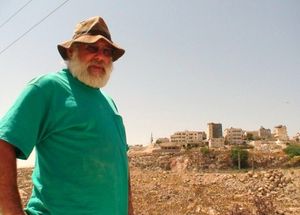Frank Barat in Agora Vox:
1-Hi Jeff. You recently took part in the Free Gaza movement (1) and successfully reached Gaza by boat with others activists, journalists and human rights workers from around the globe. How did you get involved in such an initiative and why was it important for you to take part?
 As an Israeli and the head of an Israeli peace organization (ICAHD – The Israeli Committee Against House Demolitions), I was asked by the Free Gaza Movement organizers to take part in their action to Break the Siege of Gaza by sailing two boats from Cyprus to Gaza City port. I agreed because this was a non-violent political action; breaking the siege and by implication highlighting Israel’s responsibility for it (which it tries to shrug) fit into ICAHD’s mission, to end the Israeli Occupation completely. Had this been defined as a humanitarian mission I would not have participated, since the so-called “humanitarian crisis” in Gaza is not the result of some natural calamity, but of a deliberate policy of Israel – plus the US, Europe and Japan, it must be said, and aided by Egypt – to break the will of the Palestinians to resist and to replace the democratically elected government of Hamas by a collaborationist regime more amenable to Israeli control.
As an Israeli and the head of an Israeli peace organization (ICAHD – The Israeli Committee Against House Demolitions), I was asked by the Free Gaza Movement organizers to take part in their action to Break the Siege of Gaza by sailing two boats from Cyprus to Gaza City port. I agreed because this was a non-violent political action; breaking the siege and by implication highlighting Israel’s responsibility for it (which it tries to shrug) fit into ICAHD’s mission, to end the Israeli Occupation completely. Had this been defined as a humanitarian mission I would not have participated, since the so-called “humanitarian crisis” in Gaza is not the result of some natural calamity, but of a deliberate policy of Israel – plus the US, Europe and Japan, it must be said, and aided by Egypt – to break the will of the Palestinians to resist and to replace the democratically elected government of Hamas by a collaborationist regime more amenable to Israeli control.
2-What was the goal of this initiative and has it been reached?
The goal of this initiative, as I mentioned, was to break the Israeli and international siege on Gaza – although we were careful not to disconnect Gaza from the wider Israeli Occupation of the West Bank and East Jerusalem, of which it is a part. In an important sense we succeeded. One successful action gives tremendous hope and encouragement to the people the world over that civil society initiatives can shame governments to relent and even change policy, as well as express solidarity with oppressed people. But in order to genuinely break the siege, regular boat traffic must be established. In that we have partially succeeded. So far five FGM boats have reached Gaza (the last one on December 9th, as I write this), although a Libyan ship was turned away and a boat of Palestinian-Israeli parliament members was prevented from sailing. I am in the midst of a campaign, with European supporters, to organize maritime trade unions in ports around the Mediterranean to express solidarity with Gaza, which hadn’t seen a foreign vessel in 40 years before ours arrived. One of our goals is that on appointed day in the spring or summer one or more boats will depart to Gaza from every port on the Mediterranean. Imagine what a scene, what a gesture of solidarity and resistance that would be!
3-As an Israeli Jew, what type of welcome did you get from the Gazans? Did you meet anyone from Hamas?
We all received a tremendous welcome from the Palestinian Gazans – 40,000 came out to greet us as we entered the port! As, unfortunately, the only Israeli Jew (two more have since sailed to Gaza), I was sought out by Gazans who wanted to communicate with me – in Hebrew – how much they yearned for a just peace in which all the inhabitants of the country could live together in peace.
More here.
Over the years, inventors have come up with dozens of widgets that they claim can transform the undrinkable or bring the finest wines to perfection without the long wait. Sadly, there's little scientific evidence that most of them work (see “Faking it”). Looks like you're stuck with the plonk.
